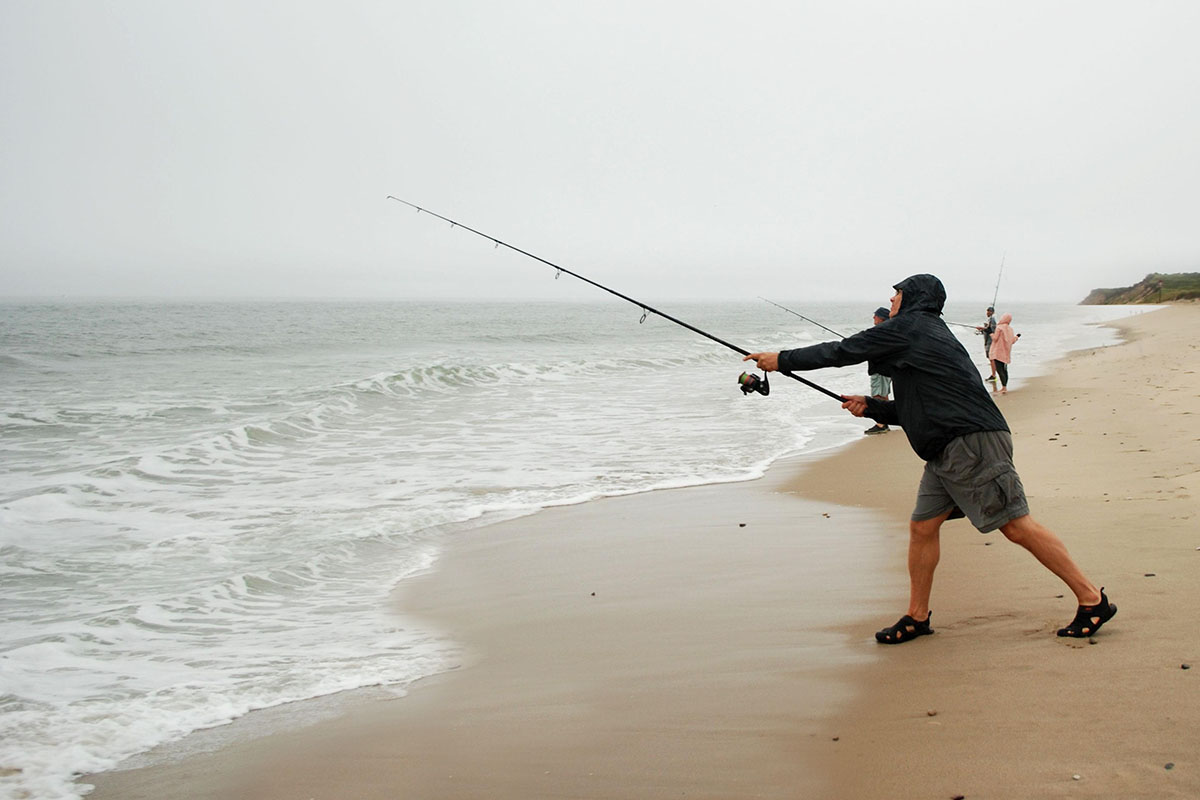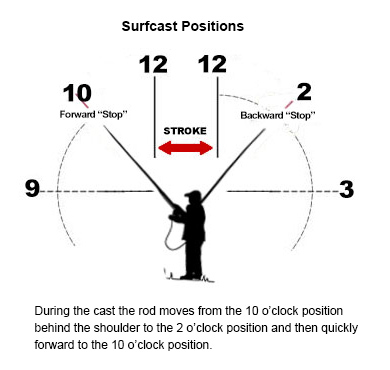Surfcasting is when you cast from the shore and/or wade into the surf to cast in the ocean. Surf casting may including casting a bait or lure from a pier, rocky or sandy beach, or jetty. Beach casting is the most common form of surfcasting. Beach casting is a type of surfcasting where the angler stands on the beach and cast near the shoreline or into the surf itself.

Surfcasting is similar to a standard overhead cast, but with a focus on distance. The goal of the cast is to land your bait in, or past, the surf where the waves break. To extend the distance of their cast, some anglers will wade into the water before casting.
- The Basic Overhead Surfcast
- Surfcasting Techniques
- Surfcasting Tips and Principles
- Surfcasting Tackle and Gear
The Basic Overhead Surfcast
The following steps will help you make a basic overhead surfcast.
- Open the bait.
- Place your finger on the line against the rod.
- Hold the rid firmly with both hands.
- Bend your arms back to bring the rod tip behind you over your shoulder to the 2 o’clock position.
- Flick the pole forward in a quick motion using your entire body.
- When the rod tip reaches the 11 to 10 o’clock position release the line and launch the bait forward.

Throw a few tests casts to evaluate your distance. Increase or decrease your distance by adjusting the speed and power of your cast.
Surfcasting Techniques
An effective surfcast incorporates proper grip, stance, and casting technique.
Gripp
Begin your cast by gripping the rod and line with your hands clasped close to together. This will prevent slack from forming in the line and interfering with fully loading your rod with energy. Place your fingers in front of and behind the reel stem.
Lift the fishing line with your index finger and move your hand backward. Only your right index finger should remain in front of the reel stem. While pressing gently against the stem, move the line up and back.
Stance
Unlike a traditional overhead cast, a surfcast is performed using the body, not the arms. A proper stance is essential to allow for a full rotation of your hips through the cast and to allow the power from your body to load the rod.
Place your feet shoulder width apart. Position your weak foot forward pointing directly toward your target. Your dominant foot should be positioned behind you at about 30 degrees to the right of your target.
Bend your knees slightly and lock your elbows in place. Rotate your hips and shoulders to move the tip of the rod back until your rod hand is at ear-level. Do not extend your rod hand behind the rear of your shoulder.
The forearm of your dominant rod hand should be pointing at about the 1 o’clock position behind you. Shift your weight to your dominant back foot before beginning the cast.
When the cast ends, your weight will be on the toes and ball of your front non-dominant foot.
Casting Technique
Again, the end goal of your casting technique is to leverage the weight and rotation of your entire body to generate the maximum power possible. To do this, begin your cast slowly, starting your motion with a slight bend of the elbow.
As you begin your cast, make sure your arms and body move in sync. If your arms get ahead of your body, your rod tip will drop too soon, and you’ll be unable to fully load your road with energy.
When your rod reaches approximately th 2 o’clock position behind your shoulder, push upward with your right hand while pulling down with right, and move the rod forward toward the target by rotating the hips in one fluid motion.
Your rod should reach maximum speed and forward momentum when your dominant arm is about 75% extended and your rod is at the 11 to 10 o’clock position. When you rod reaches maximum speed, stop your motion and at the same time release the line.
Surfcasting Tips and Principles
Following these principles will help you improve your cast and increase your distance.
- Your lure bait will continue to travel in the same direction as your rod was traveling when casting motion stops.
- The most effective casts start slow then accelerate to top speed just before your rod tip stops.
- When your rod tip reaches maximum velocity, stop your motion quickly, keep your tip pointing toward your target trajectory and don’t let your rod tip fall.
- The longer your stroke, the farther your cast will reach. Increasing your stroke will increase your casting distance.
Surfcasting Tackle and Gear
There are key pieces of gear and tackle required to keep you safe and productive when surf fishing. At minimum surf fishing rods and reels are need to be able to make the distance casts required to get your bait beyond the surf, but you’re going to want more than just a good rod and reel.
The type of surf fishing gear you’ll need will depend on the types of surf casts you’ll be making and the environment you’ll be fishing. The following is a full list of recommended surf fishing gear and tackle for all likely surf fishing environments.
- 8 to 12 foot medium heavy rod with medium-moderate action
Heavy-duty, corrosion-resistant 6000 to 8000 series spinning reel. - 20 to 50 pound test line with 30 to 50 pound test leader line.
- Hooks ranging in size from 1/0 to 10/0. Hook size and type will depend on target fish species and size of bait. Inline Octopus, Circle or Kahle hooks are common hooks for surf fishing.
- 4 to 8 ounce tournament or break-out sinkers (use heavier sinkers when fishing areas with strong current or tidal movement).
- Go-to lures and baits for surf fishing including jigs, plugs, soft plastic and metal spoons, or if possible, live bait such as shrimp or crabs.
- A surf fishing rig for the target fish species and conditions.
- Rod holder or sand spike to hold your rod in place and your reel off the sand.
- Surf belt of securing gear when wade fishing.
- A BogaGrip style scale for weighing fish from the beach or surf.
- A set of pliers with good cutters.
- Surf bag with a secure velcro flap.
- A breathable set of stocking or boot foot waders.
- Surf top for staying warm and dry. Either a zipper top or pullover.



